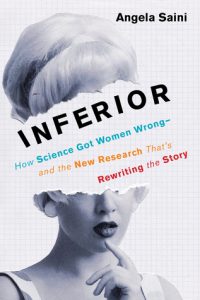Art and Culture
Sex and the Seductions of Social Explanation
At its best, commentary on the science of sex differences has been about method and about evidence, and the knowledge that, with care, these can produce.

A review of Inferior: How Science Got Women Wrong and the New Research That’s Rewriting the Story, by Angela Saini. Beacon Press (May 30 2017) 224 pages.
I saw a funny cartoon: a man lies hopelessly drunk in a gutter while, slumped next door, his bulbous-nosed friend utters the punchline: “He’s been celebrating not having the alcoholism gene again.” This was a long time ago, when I was a researcher in a university psychology department, and the cartoon was pinned to the door of a senior colleague working on the social psychology of alcoholism. He was a man, it’s safe to say, who didn’t like genetic explanations for human behaviour.
Over the years I’d largely forgotten about the cartoon, as well as most of what I once knew about psychology. The memory came back to me in recent months, however, as the long-simmering question of what kind of explanations we should give when we turn our attention to ourselves, to questions of human behaviour, has boiled over. Once again there is a partisanship for certain types of explanation, and choices seem to be based as much on politics and personal preference as epistemology.
This was all too clear in the gang fight that erupted around James Damore’s Google memo and which soon embroiled the science of sex differences more generally. Writing in the Guardian, Angela Saini accused Damore and his allies of a lazy reach for biological explanations when faced with the reality of men’s dominance of tech industries—
The “myriad historical, cultural and social factors that create inequality are all too easily glossed over,” she noted, if we immediately invoke biological causes. But many of those attacking Damore simply ruled biological explanation out of court as inherently reactionary (here and here, for instance). They insisted that anything relating to differential behaviours or outcomes for men and women should be attributed 100% to social and cultural factors – attributing any variance to biology was simply impermissible.
At its best, commentary on the science of sex differences has been about method and about evidence, and the knowledge that, with care, these can produce. At the very least, the research has been the subject of intense scrutiny. My point here is not to revisit this science, but rather to suggest that there is an asymmetry in which explanations based on biology are analysed with rigour, whilst alternative explanations based on social causation are simply tossed out as some kind of commonsense or backed-up with thin and often speculative historical evidence. That doesn’t, of course, mean social explanations are always wrong; but it does mean that the current terms of debate about sex differences in behaviour are liable to mislead, implying that adequate social explanations are always available and already in place.
I have presented the explanatory options for human behaviour as a choice between the social and the biological. This isn’t, of course, the case. Jared Diamond starts his popular global history Guns, Germs and Steel with the question of why Europeans turned up in others’ harbours and not vice versa. His answer comes from geography: the crops that can be grown, the animals husbanded, and the resources available in different places. Nor, of course, should biological explanation be seen as exhausted by the genetic. It has been suggested, for example, if not proved, that birth order has some impact on male sexual orientation. However, I am going to stick with the social versus biological dichotomy here (and the reduction of biological explanation to the genetic) as these are the leading candidates in debate over sex differences. I also lump together Saini’s “myriad historical, social and cultural factors” under the shorthand of social explanation; the failure to distinguish between these with any precision is part of my point.
I would suggest, entirely speculatively, that a number of factors make social explanations attractive, whether for sex differences or other questions about being human. Social explanations work well in a number of contexts (history and everyday life, for example), so why not extend them further? They offer explanations in terms of human purposes – who benefitted, what did they want? – a form of explanation that seems to come naturally to us. They can also seem to be progressive, offering the possibility that desirable outcomes (like more women in tech jobs) can be achieved through straightforward social change. Finally, it seems to me, there’s a certain reflexive kick against the full implications of natural selection; we want to separate out the explanations we give for human behaviour from the kind we give to other animals, to explain ourselves solely through our own creations of culture and history.
Angela Saini, who I quoted earlier, is a challenge to this final speculation. She has previously argued explicitly for the need to understand humans through their place in nature, and against those who instinctively deny that natural history has any relevance to human outcomes. Yet she too, I would suggest, applies a double standard in her approach to different types of explanation: vigorously challenging biological causation but giving social theories a free pass.

Saini has developed her take on the science of sex differences into a book, Inferior: How Science Got Women Wrong and the New Research That’s Rewriting the Story. In it she makes the argument that feminism has served to advance research. Feminism has improved the interpretation of data and encouraged more creative theorising by helping scientists see past earlier assumptions about gendered behaviour. In this she is undoubtedly right and her book worthwhile. However, she has a second aim, which is to demonstrate that “male domination and patriarchy are not biologically hardwired into human society, as some have claimed,” and it is in filling the explanatory gap that this leaves, by positing social causes for the reality of male dominance, that her account becomes problematic.
Saini takes on the claim that women are less interested in sex (having it, that is, not studying sex difference) and in particular evolutionary explanations for why that might be. She cites Sarah Hrdy’s work on the ubiquity of social practices which celebrate women’s pre-marital virginity, and later monogamy, but that also police women who might be tempted to stray, at the extreme through such vicious acts as female genital mutilation. But she is unclear on whether her claim is that women are eager for sex (on average) but in perpetual conflict with these social practices, or instead that women internalise the concepts as part of their culture and so do exhibit, in her term, chaste behaviour. Her statement that women have been “left with little choice but to behave in ways that served the system” doesn’t really distinguish between the two, and without this distinction it is hard to judge the adequacy of the account.
Proposing that cultural constraints on sexual interest are indeed internalised would be, in effect, to invoke a theory of ideology, and Saini notably avoids this. Whilst that’s understandable in a popular science book, it makes any claims about culturally determined behaviour broad brush at best. It also side-steps the questions that such a theory, by being more explicit, would have opened up. What is the mental mechanism by which desire is shaped by ideas? Can we trace dose effects whereby the strength of a society’s taboo on active female sexuality equates to the level of women’s sexual interest? How can such a theory explain the way a woman’s sex drive appears to change over her life course?

Saini’s discussion of women’s sexual appetite is part of a larger exploration of the origins of patriarchy, of women’s oppression as a deep regularity in human societies, or, as she more succinctly puts it in a chapter heading, “Why Men Dominate.” Having ruled out biological explanation by fiat, Saini looks to social causes, unfurled through history. The evidence presented, however, is brittle. In her introduction, she asserts that “we were once an egalitarian species” but no information that I can find is offered to support the claim. The turn away from egalitarianism and towards a gendered hierarchy is associated, in Saini’s historical narrative, with the first agricultural revolution, when humans moved to settled farming.
However, the causal link explaining why this should have happened is barely sketched out. Melvin Konner is quoted to the effect that denser societies and specialisation meant there was a critical mass of men who could then exclude women, but the why and how of this seems to be taken as too obvious to state. Why would men want to exclude women in such a situation? If men and women had been living equitably, why would either sex accept this loss? In Saini’s historical sketch the process of disparity then became self-reinforcing. Men accumulated land, property, and wealth and wanted to ensure that this was passed to their children, so pre-marital chastity for girls and the fidelity of wives was enforced. Again, the assumptions here are not considered to need defending. Why was it men who held property? Why was inheritance considered of such primary importance? How did the interests of property holding men become wider social norms? Critics of evolutionary psychology have claimed that it creates poorly evidenced descriptions of pre-historic life in order to justify claims about the present. In Inferior, Saini seems to be making just this move.
Whilst there is passing reference to Friedrich Engels’s Victorian fantasies of the Neolithic, Saini’s main source on prehistory is Gerda Lerner’s influential 1986 work The Creation of Patriarchy. However, while Lerner gives much detail about the codification of women’s subjugation in the first civilisations of the Near East, she is largely silent – excepting another, if slightly more skeptical, invocation of Engels – on how this arose in the first place. Lerner does, though, posit that act as a kind of original sin, as the antecedent of both slavery and class division. Saini repeats this claim about slavery, though with an equivocating “may even have,” which rather puts in doubt her belief in the security of Lerner’s other assertions. Indeed, at the outset of The Creation of Patriarchy, Lerner herself says that the evidence for prehistory (rather than early civilisations) is so ambiguous that our interpretation will inevitably be determined by our pre-existing assumptions (our “conceptual framework”); not the basis for anyone to rest too much confidence on her conclusions.
Historical explanations are, by their nature, specific to the society under consideration. If the same pattern is observed in multiple places or at multiple times then such explanations will always have a challenge in accounting for this. Saini quotes Hrdy on patriarchy as a common feature of multiple cultures but is vague about how her historical narrative explains this. She talks about how “patriarchies grew and spread,” but if that’s a claim that patriarchy in Japan arose from patriarchy in Mesopotamia then it needs a lot more justification.

I wonder if Saini senses some of these difficulties as her discussion moves out of human history altogether and returns to science, with a consideration of pre-human evolution and the sexual behaviour of our primate relatives. She notes how primatologists have traditionally seen the chimpanzee, with its violent, dominant males, as the model of human behaviour, but that recent research has suggested that another human relative, the bonobo, is matriarchal; co-operation between unrelated females allows them to dominate the physically larger males. This is interesting and again usefully embeds humans within an evolutionary context, whilst suggesting this can be looked at in a new way. However, when Saini muses on whether it’s “possible that somewhere in our evolutionary history we were matriarchal as bonobos appear to be” she seems to have lost sight of the fact that what needs explaining in humans is the prevalence of patriarchy.
My critique of social explanations for sex differences is not, of course, evidence in favour of biological explanations. I think Saini is right to be suspicious of an easy reach for the biological, especially if that is merely an invocation of prejudices about what is natural rather than a reference to the actual science. However, social explanation will always be challenged in accounting for deep, cross-cultural regularities in human behaviour. If authors want to advance such arguments as alternatives to the biological then they need to do so with caution. It is wrong to assume that social explanations are commonsensical and can be approached without theory, and it is wrong to assume that evidence in history doesn’t need the same care as evidence in science.
Saini is more sophisticated than some in this debate in accepting that human history will connect with natural history. However, she seems to be in thrall to the idea that only through a social explanation for men’s historical dominance can there be the possibility of progressive change; that if biology is given explanatory power in relation to the past then it must of necessity determine the future. This is illogical. Saini sees the way female Bonobos triumph through co-operation as inspiring. It’s perfectly possible to agree with that, and to see female bonobos as an example for political organisation for the future, whilst still accepting that chimpanzees provide a more convincing model of our evolutionary past.






